Practical Writing--Resume and Cover letter
- 格式:doc
- 大小:79.00 KB
- 文档页数:10
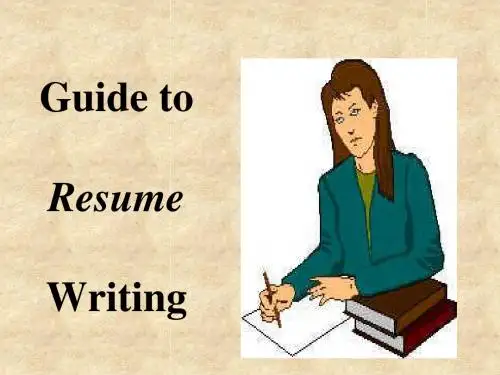
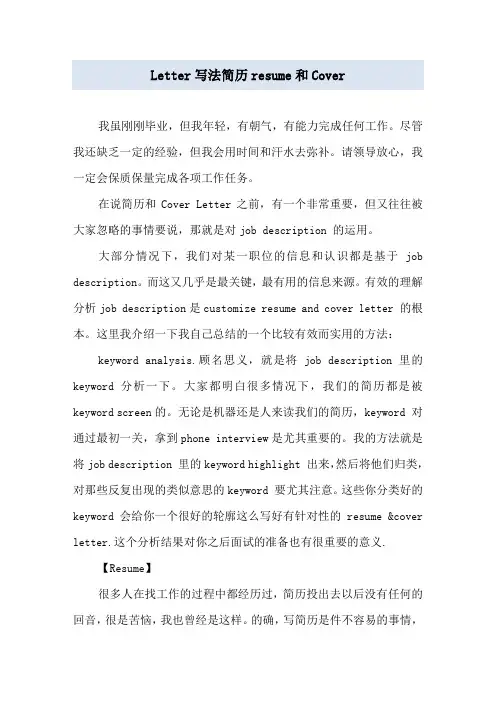
Letter写法简历resume和Cover我虽刚刚毕业,但我年轻,有朝气,有能力完成任何工作。
尽管我还缺乏一定的经验,但我会用时间和汗水去弥补。
请领导放心,我一定会保质保量完成各项工作任务。
在说简历和Cover Letter之前,有一个非常重要,但又往往被大家忽略的事情要说,那就是对job description 的运用。
大部分情况下,我们对某一职位的信息和认识都是基于job description。
而这又几乎是最关键,最有用的信息来源。
有效的理解分析job description是customize resume and cover letter 的根本。
这里我介绍一下我自己总结的一个比较有效而实用的方法:keyword analysis.顾名思义,就是将job description 里的keyword 分析一下。
大家都明白很多情况下,我们的简历都是被keyword screen的。
无论是机器还是人来读我们的简历,keyword 对通过最初一关,拿到phone interview是尤其重要的。
我的方法就是将job description 里的keyword highlight 出来,然后将他们归类,对那些反复出现的类似意思的keyword 要尤其注意。
这些你分类好的keyword会给你一个很好的轮廓这么写好有针对性的resume &cover letter.这个分析结果对你之后面试的准备也有很重要的意义.【Resume】很多人在找工作的过程中都经历过,简历投出去以后没有任何的回音,很是苦恼,我也曾经是这样。
的确,写简历是件不容易的事情,但是它又是非常重要的第一步,也是找工作过程中很少一些可以由我们来控制的东西。
所以大家都意识到其重要性。
Generally speaking,每个人因为各自专业和背景的不同,简历都非常的不同。
不过还是有些guidelines can be followed.以下就是一些我的总结:1.没有针对性的简历的用处很小,所以务必认真的根据不用的职位修改,这里就用到了keyword analysis的结果.2.简历要经过千锤百炼,反复修改.我的简历改过不下20多遍.3.多看看别人写的简历,无论是格式和内容,特别是跟自己背景相似的简历有很大的启发和参考价值.4.写好建立初稿后,给不同的人看,(最好能有过来人的意见).征求他们的意见.最有效的方法就是给他们看看你要申请的job description,然后问他们是否觉得从你简历上看match.Honest opinions are best!!!5.Objective/profile is useful to highlight your qualifications.务必根据你对keyword 的分类结果合理的强调.Think it as “five second commercial of yourself”.cation or professional/working experience,which one should put first?我个人觉得你自己觉得哪个更significant or which one the position cares more,then put that one first.(Again,based on the results in keyword analysis)Gender和Sex不要搞混:Gender是社会性别,Sex是生物性别,也叫自然性别。
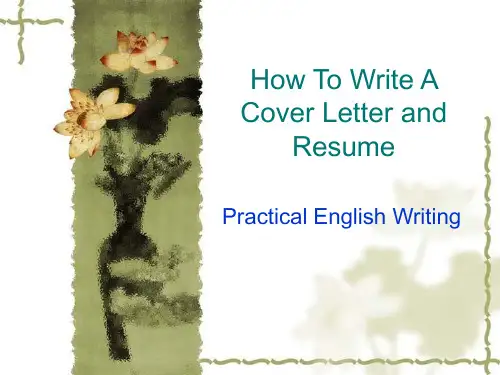
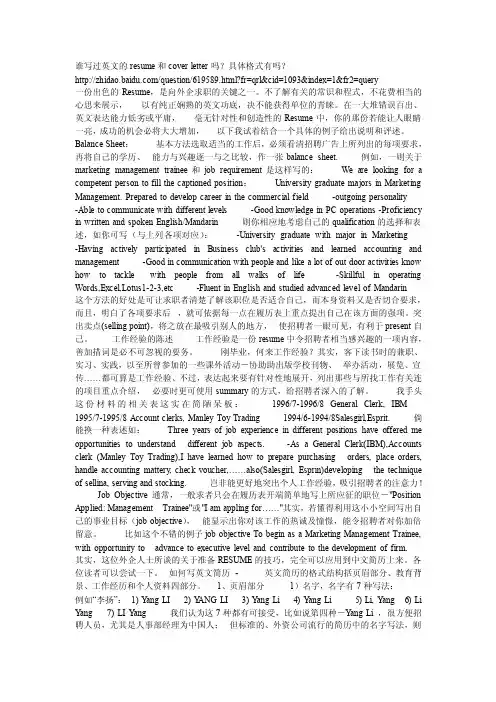
谁写过英文的resume和cover letter吗?具体格式有吗?/question/619589.html?fr=qrl&cid=1093&index=1&fr2=query一份出色的Resume,是向外企求职的关键之一。
不了解有关的常识和程式,不花费相当的心思来展示,以有纯正娴熟的英文功底,决不能获得单位的青睐。
在一大堆错误百出、英文表达能力低劣或平庸,毫无针对性和创造性的Resume中,你的那份若能让人眼睛一亮,成功的机会必将大大增加,以下我试着结合一个具体的例子给出说明和评述。
Balance Sheet:基本方法选取适当的工作后,必须看清招聘广告上所列出的每项要求,再将自己的学历、能力与兴趣逐一与之比较,作一张balance sheet.例如,一则关于marketing management trainee和job requirement是这样写的:We are looking for a competent person to fill the captioned position:University graduate majors in Marketing Management. Prepared to develop career in the commercial field-outgoing personality-Able to communicate with different levels-Good knowledge in PC operations -Proficiency in written and spoken English/Mandarin则你相应地考虑自己的qualification的选择和表述,如你可写(与上列各项对应):-University graduate with major in Marketing-Having actively participated in Business club's activities and learned accounting and management-Good in communication with people and like a lot of out door activities know how to tackle with people from all walks of life-Skillful in operating Words,Excel,Lotus1-2-3,etc-Fluent in English and studied advanced level of Mandarin这个方法的好处是可让求职者清楚了解该职位是否适合自己,而本身资料又是否切合要求,而且,明白了各项要求后,就可依据每一点在履历表上重点提出自己在该方面的强项。
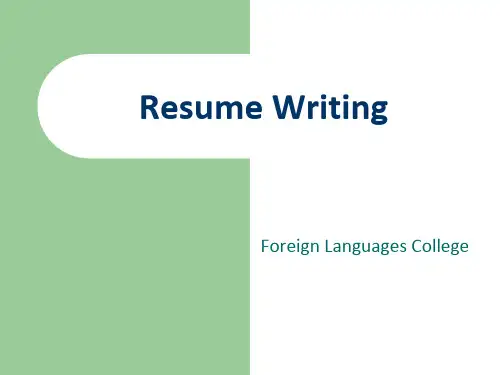
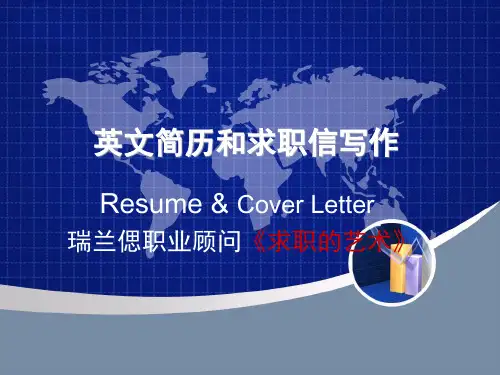
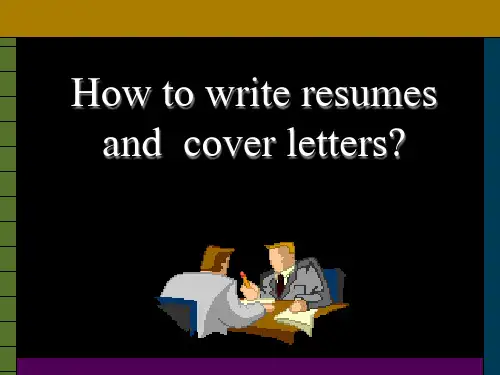
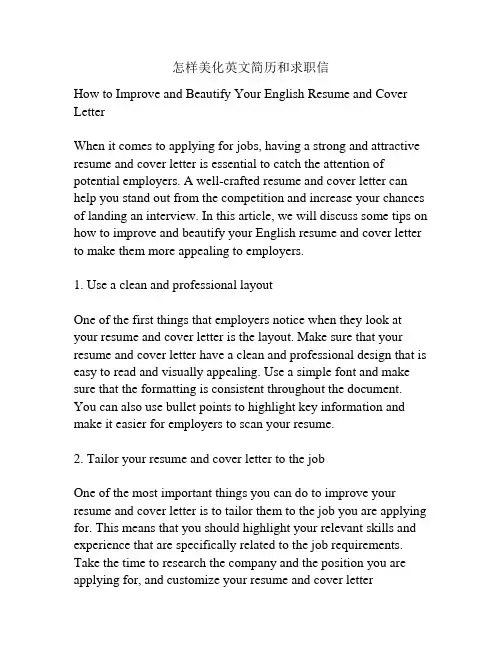
怎样美化英文简历和求职信How to Improve and Beautify Your English Resume and Cover LetterWhen it comes to applying for jobs, having a strong and attractive resume and cover letter is essential to catch the attention of potential employers. A well-crafted resume and cover letter can help you stand out from the competition and increase your chances of landing an interview. In this article, we will discuss some tips on how to improve and beautify your English resume and cover letter to make them more appealing to employers.1. Use a clean and professional layoutOne of the first things that employers notice when they look at your resume and cover letter is the layout. Make sure that your resume and cover letter have a clean and professional design that is easy to read and visually appealing. Use a simple font and make sure that the formatting is consistent throughout the document. You can also use bullet points to highlight key information and make it easier for employers to scan your resume.2. Tailor your resume and cover letter to the jobOne of the most important things you can do to improve your resume and cover letter is to tailor them to the job you are applying for. This means that you should highlight your relevant skills and experience that are specifically related to the job requirements. Take the time to research the company and the position you are applying for, and customize your resume and cover letteraccordingly. This will show employers that you are serious about the job and that you have taken the time to understand their needs.3. Highlight your achievements and accomplishmentsWhen writing your resume and cover letter, it is important to highlight your achievements and accomplishments. This will give employers a clear sense of what you have achieved in your previous roles and what you can bring to their organization. Use specific examples to demonstrate your skills and experience, and quantify your achievements whenever possible. For example, instead of simply stating that you increased sales, you could say that you increased sales by 20% within six months.4. Use keywords and buzzwordsMany companies use applicant tracking systems (ATS) to screen resumes and cover letters for specific keywords and buzzwords. To improve your chances of getting noticed by these systems, make sure to include relevant keywords and buzzwords in your resume and cover letter. These can be skills, experiences, or qualifications that are commonly used in the industry or the job you are applying for. You can find these keywords by carefully reading the job description and using them in your application.5. Be concise and to the pointEmployers receive hundreds of resumes and cover letters for each job opening, so it is important to be concise and to the point when writing your application. Keep your resume to one or two pagesand your cover letter to one page. Use short paragraphs and bullet points to make it easy for employers to scan your application. Avoid using too much jargon or technical language, and focus on highlighting your most important qualifications and experiences.6. Proofread and edit carefullyBefore submitting your resume and cover letter, make sure to proofread and edit them carefully. Check for spelling and grammar errors, and make sure that the formatting is consistent throughout the document. Ask a friend or colleague to review your application and provide feedback. A fresh pair of eyes can help you catch any mistakes or areas for improvement that you may have missed. Remember that attention to detail is important, and employers will notice if your application is well-written and error-free.In conclusion, improving and beautifying your English resume and cover letter can make a big difference in your job search. By using a clean and professional layout, tailoring your application to the job, highlighting your achievements, using keywords and buzzwords, being concise and to the point, and proofreading carefully, you can create a strong and attractive application that will impress potential employers. Good luck with your job search!。
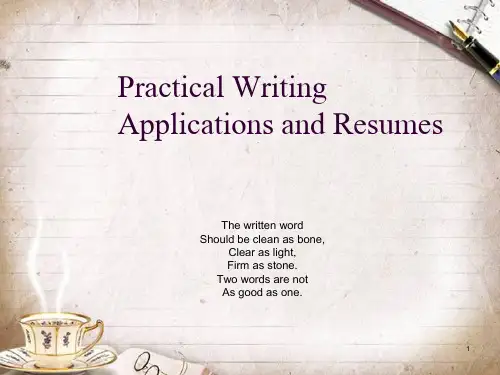
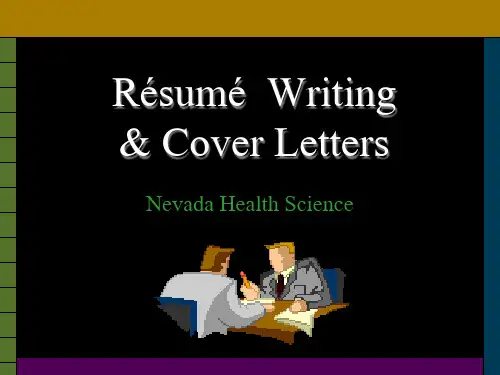
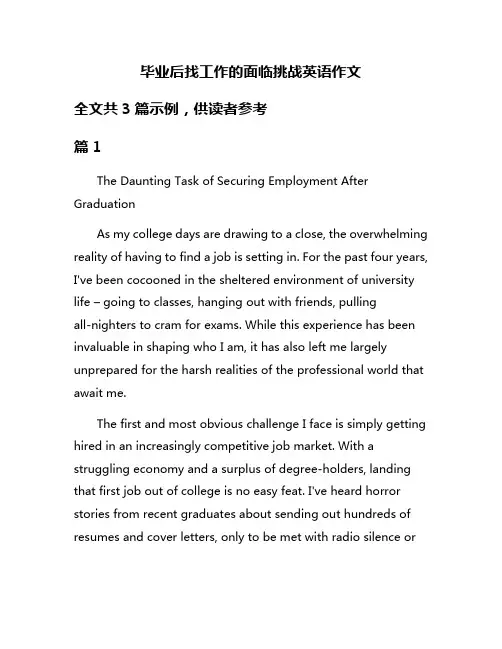
毕业后找工作的面临挑战英语作文全文共3篇示例,供读者参考篇1The Daunting Task of Securing Employment After GraduationAs my college days are drawing to a close, the overwhelming reality of having to find a job is setting in. For the past four years, I've been cocooned in the sheltered environment of university life – going to classes, hanging out with friends, pullingall-nighters to cram for exams. While this experience has been invaluable in shaping who I am, it has also left me largely unprepared for the harsh realities of the professional world that await me.The first and most obvious challenge I face is simply getting hired in an increasingly competitive job market. With a struggling economy and a surplus of degree-holders, landing that first job out of college is no easy feat. I've heard horror stories from recent graduates about sending out hundreds of resumes and cover letters, only to be met with radio silence orcurt rejection emails. The prospect of such an uphill battle is demoralizing, to say the least.Even if I do manage to get my foot in the door with interviews, I'm gripped by fears of being ill-equipped to impress potential employers. In the academic setting, success is primarily measured by test scores, GPA, and the ability to recite facts learned from textbooks. However, the working world seems to place more emphasis on practical experience, specialized skills, and the ability to think critically and solve real-world problems. My lack of professional experience makes me feel like I'm at a disadvantage compared to those who had internships or co-op placements during their studies.Moreover, I can't help but be intimidated by the prospect of navigating the corporate landscape as a fresh-faced newcomer. University has provided me with theoretical knowledge, but there's a whole unwritten code of conduct in the workplace that I have yet to grasp. How do I conduct myself in meetings? How do I communicate effectively with superiors and colleagues? How do I deal with office politics and potential conflicts? These are all aspects of work life that simply can't be learned from a textbook.Then there's the issue of having to relocate for a job opportunity, which is a very real possibility given the current jobmarket. While the idea of moving to a new city is exciting, it's also fraught with challenges – finding affordable housing, adapting to a new environment, being away from family and friends. The thought of having to uproot my life and start fresh somewhere else is both thrilling and terrifying.Perhaps the biggest challenge I face, however, is the overwhelming sense of uncertainty about my future. For the past few decades, I've been able to follow a relatively structured path – elementary school, middle school, high school, college. Each step had a clear goal, and once I achieved it, the next step was mapped out. Now, as I stand on the precipice of the "real world," I'm plagued by doubts and endless questions. What if I can't find a job in my desired field? What if I end up in a career I'm not passionate about? What if I make the wrong choices and end up regretting them down the line?Despite all these concerns, I know that I must press on and confront these challenges head-on. Complacency and fear of the unknown will only hold me back from reaching my full potential. It's a daunting and uncertain road ahead, but I'm determined to tackle it with resilience, optimism, and a willingness to learn and adapt.After all, life is about taking risks and stepping out of one's comfort zone. While the transition from student to professional may be fraught with obstacles, it's also an opportunity for growth, self-discovery, and the realization of my ambitions. I may stumble and face setbacks along the way, but each experience will be a valuable lesson that shapes my character and future.As I bid farewell to the familiarity of university life, I'm filled with a bittersweet mix of nostalgia and excitement for what lies ahead. The challenges are formidable, but I'm ready to embrace them and embark on this new chapter of my life's journey. With hard work, perseverance, and a positive attitude, I'm confident that I can overcome the hurdles and carve out a fulfilling and rewarding career path for myself. The road may be long and winding, but the destination is worth the struggle.篇2The Daunting Task of Finding a Job After GraduationAs I approach the end of my university journey, a new challenge looms on the horizon – the intimidating task of securing a job in the real world. The transition from the structured environment of academia to the ever-evolving landscape of the job market is a daunting one, fraught withuncertainties and obstacles that fill me with a mixture of excitement and trepidation.The first and most formidable hurdle I anticipate facing is the sheer competition in the job market. With the ever-increasing number of graduates entering the workforce each year, the competition for coveted positions has become fiercer than ever before. It's a sobering reality that for every job opening, there are countless qualified candidates vying for the same opportunity. This intense competition demands that I not only excel academically but also possess a diverse set of skills and experiences that set me apart from the crowd.Adding to the complexity of the job search is the constantly evolving nature of the job market itself. The advent of new technologies, shifting industry trends, and ever-changing employer demands have made it imperative for me to be adaptable and versatile. The skills and knowledge I have acquired during my university years may quickly become obsolete, necessitating a commitment to lifelong learning and professional development. Navigating this dynamic landscape requires a keen awareness of industry trends, a willingness to embrace change, and the ability to continuously upskill and reinvent myself.Another significant challenge I anticipate facing is the transition from the structured academic environment to the professional world. University has provided me with a comfortable routine and a support system that has guided my learning and personal growth. However, the workplace operates under different rules and expectations, and the adjustment to this new reality can be overwhelming. I must be prepared to adapt to a corporate culture, navigate office politics, and develop the resilience to handle the pressures and demands of a full-time job.Furthermore, the job search process itself can be a grueling and emotionally draining experience. Writing countless resumes and cover letters, attending interviews, and potentially facing rejection can take a toll on one's confidence and motivation. It is crucial for me to develop a thick skin and maintain a positive mindset throughout this process, as perseverance and resilience are key to ultimately securing the right opportunity.Networking and building professional connections also present a significant challenge for many fresh graduates like myself. While the importance of networking has been emphasized time and time again, putting it into practice can be intimidating. Stepping out of my comfort zone, attendingindustry events, and actively seeking out mentors and professionals in my field of interest require confidence and strong interpersonal skills – skills that may not have been fully developed during my academic years.Despite these challenges, I remain optimistic and determined to overcome them. I recognize that the path to securing a fulfilling career may not be a linear one, and I must be prepared to embrace detours and unexpected opportunities along the way. Remaining open-minded, adaptable, and persistent will be key to navigating this phase of my life successfully.To better equip myself for the challenges ahead, I have been actively seeking out internships and volunteering opportunities to gain practical experience and build my professional network. Additionally, I have been working closely with my university's career services to refine my job search strategies, polish my resume and cover letters, and prepare for interviews.While the road ahead is undoubtedly challenging, I am comforted by the knowledge that countless graduates before me have successfully navigated this transition. With hard work, determination, and a willingness to learn and adapt, I amconfident that I too can overcome these obstacles and secure a fulfilling career that aligns with my passions and aspirations.The journey from graduation to securing a job may be a arduous one, but it is a necessary rite of passage that will shape my personal and professional growth. By embracing the challenges head-on, I will emerge as a more resilient, adaptable, and well-rounded individual, better prepared to thrive in the ever-changing landscape of the modern workforce.篇3The Daunting Challenge of Landing that First Job After CollegeAs I approach the end of my college journey, a new and daunting challenge looms before me – finding my first real job in the professional world. For the past four years, my primary focus has been on academics, extracurriculars, and frankly, just surviving the roller coaster ride of university life. But now, the stakes feel higher than ever as I prepare to take thatnerve-wracking step into the job market.The pressure to secure employment after graduation is immense. It's not just about financial independence or putting that hard-earned degree to use; it's about proving to myself andthe world that I'm capable of thriving in the real world. The transition from student to professional is a rite of passage that fills me with equal parts excitement and trepidation.One of the biggest challenges I face is the sheer competition in today's job market. With each passing year, the pool of qualified candidates seems to grow larger, making it increasingly difficult to stand out from the crowd. Employers can afford to be incredibly selective, and even entry-level positions require a wealth of experience, skills, and accomplishments that can be challenging for a fresh graduate to possess.Crafting the perfect resume and cover letter is an art form in itself. How do I effectively convey my capabilities, achievements, and potential in just a few pages? How can I make my application shine amidst hundreds, if not thousands, of others? It's a delicate balance between selling myself and avoiding the dreaded perception of overconfidence or arrogance.Then there's the interview process – a true test of nerves and quick thinking. Anticipating and preparing for the myriad of potential questions, from behavioral to technical, is a daunting task. How can I convince the interviewer that I'm the ideal candidate when my real-world experience is limited? How do Iproject confidence and poise when my palms are sweating, and my heart is racing?Beyond the technical aspects of the job search, there's also the emotional toll it can take. Rejection is an inevitable part of the process, but that doesn't make it any easier to swallow. Each time I receive a polite but impersonal rejection email or don't hear back at all, it chips away at my self-confidence and determination. It's a constant battle to remain motivated and resilient in the face of disappointment.Furthermore, the pressure to find not just any job, but the right job, can be overwhelming. As a fresh graduate, I'm often torn between accepting an opportunity that may not be my dream role or holding out for the perfect fit. Do I settle for something that pays the bills, or do I risk prolonging my job search in hopes of finding that elusive, fulfilling career path?Adding to the complexity is the ever-changing nature of the job market itself. The skills and qualifications that were in demand just a few years ago may now be obsolete, thanks to rapid technological advancements and shifting industry trends. Staying ahead of the curve and adapting to these changes is a constant challenge, especially for someone just starting out in their career.Despite these formidable obstacles, I remain determined to forge ahead and conquer this next chapter of my life. I draw strength from the knowledge that countless others before me have successfully navigated this treacherous terrain and emerged victorious on the other side.I remind myself that the challenges I face are not unique; they are a shared experience among graduates worldwide. By networking, seeking mentorship, and learning from the experiences of those who have gone before me, I can gain valuable insights and strategies for navigating the job search process.Moreover, I've come to realize that the challenges themselves are not necessarily obstacles, but rather opportunities for personal growth and resilience. Each rejection, each nerve-wracking interview, and each setback serves as a valuable lesson in perseverance, adaptability, and self-belief.As daunting as the prospect of finding that first job may be, I remain hopeful and optimistic. I have faith in my abilities, my education, and my determination to succeed. The challenges I face are not insurmountable; they are simply hurdles to be cleared on the path to a fulfilling and rewarding career.So, as I don the cap and gown and receive my hard-earned diploma, I embrace the challenges that lie ahead. Armed with the knowledge, skills, and experiences I've gained throughout my academic journey, I am ready to embark on this new and exciting chapter of my life. The road may be long and winding, but with unwavering determination and a positive mindset, I am confident that I will emerge triumphant, securing that elusive first job and paving the way for a successful and rewarding professional future.。
就业的建议英语作文In the current competitive job market, securing a desirable position requires not only a solid educational background but also a strategic approach to job hunting. Here are some suggestions to help you navigate the employment landscape effectively:1. Self-assessment: Begin by understanding your strengths, weaknesses, and career goals. This introspection will guide you in identifying the types of jobs that align with your skills and aspirations.2. Skill Development: Continuously enhance your skills through professional courses, workshops, and certifications. Staying updated with industry trends and technologies will make you a more attractive candidate.3. Networking: Establish connections with professionals in your field. Attend industry conferences, join online forums, and leverage social media platforms like LinkedIn to build a strong professional network.4. Resume and Cover Letter: Craft a compelling resume and cover letter that highlight your achievements and skills. Tailor these documents to each job application to demonstrate your genuine interest and suitability for the role.5. Interview Preparation: Practice common interview questionsand prepare to discuss your experiences in detail. Research the company and its values to show your enthusiasm and fit during the interview.6. Job Search Platforms: Utilize job search engines, company websites, and recruitment agencies to find job openings. Regularly check these platforms and set up alerts for new opportunities.7. Internships and Volunteering: Gain practical experience through internships or volunteering. These experiences can provide valuable insights into the industry and may lead to full-time job offers.8. Mentorship: Seek guidance from a mentor in your field. They can provide career advice, introduce you to industry contacts, and help you navigate professional challenges.9. Professionalism: Maintain a high level of professionalism in all your interactions, from your online presence to your in-person meetings with potential employers.10. Persistence and Positivity: Job hunting can be a lengthy process. Stay persistent, keep a positive attitude, and be open to feedback and learning opportunities.11. Work-Life Balance: While job searching, do not neglect your personal well-being. Maintain a healthy work-life balance to ensure you are at your best during interviews and networking events.12. Post-Application Follow-Up: After submitting your application or completing an interview, follow up with a thank-you email to express your continued interest in the position and to keep your application fresh in the employer's mind.By implementing these strategies, you can increase your chances of securing a job that not only meets your financial needs but also provides personal fulfillment and career growth opportunities. Remember, the job market is dynamic, and staying adaptable and proactive is key to success.。
如何找到工作英语作文How to Find a Job。
Finding a job can be a daunting task, especially in today's competitive job market. However, with the right approach and a bit of persistence, you can increase your chances of landing your dream job. Here are some tips on how to find a job.1. Identify your strengths and weaknesses。
Before you start your job search, it's important to identify your strengths and weaknesses. This will help you focus your job search on industries and roles that suit your skills and experience. Take some time to reflect on your past work experience, education, and personal interests to determine what you're good at and what you enjoy doing.2. Create a strong resume and cover letter。
Your resume and cover letter are your first impression with potential employers, so it's important to make them strong and professional. Tailor your resume and coverletter to the job you're applying for, highlighting your relevant skills and experience. Use a clear and concise format, and proofread for errors before submitting.3. Network。
关于大学生就业的英语作文As college students, finding a job after graduation is always a top priority. The job market is competitive, and it can be overwhelming to think about the future. However, with determination and hard work, we can overcome any challenges that come our way.One of the most important things to remember when looking for a job is to network. Building connections with professionals in your field can open up many opportunities for you. Attend career fairs, join professional organizations, and reach out to alumni for advice and guidance. Networking can help you find hidden job opportunities and get your foot in the door at top companies.In addition to networking, it's crucial to gain relevant work experience while still in college. Internships, part-time jobs, and volunteer work can all help build your resume and make you a more attractivecandidate to potential employers. Employers want to seethat you have practical skills and real-world experience, so don't hesitate to take on different roles and responsibilities to expand your skill set.When applying for jobs, make sure to tailor your resume and cover letter to each position you're interested in. Highlight your relevant experience, skills, and accomplishments that align with the job requirements. Personalize your application to show the employer that you are genuinely interested in the position and company. A well-crafted resume and cover letter can make a big difference in getting noticed by employers.Lastly, don't be afraid to seek help and guidance from career services at your university. They can provide valuable resources, workshops, and one-on-one counseling to help you navigate the job search process. Take advantage of all the support available to you and don't hesitate to ask for help when you need it.In conclusion, finding a job as a college student mayseem daunting, but with the right mindset and strategies, you can achieve success. Stay proactive, network, gain relevant experience, tailor your applications, and seek help when needed. Remember that your hard work and determination will pay off in the end. Good luck on your job search!。
英语作文如何缓解就业压力Title: Strategies to Alleviate Employment Pressure。
In today's competitive job market, many individuals experience significant pressure when it comes to securing employment. However, there are several effective strategies to alleviate this stress and enhance one's prospects. In this essay, we will explore various approaches to mitigate employment pressure.Firstly, it is crucial to maintain a positive mindset and adopt a proactive attitude towards job hunting. Instead of viewing the job search process as daunting, consider it as an opportunity for personal and professional growth. Setting realistic goals and breaking down the job search into manageable tasks can make the process seem less overwhelming. Additionally, staying optimistic andresilient in the face of rejections is essential for maintaining motivation.Networking plays a pivotal role in finding employment opportunities. Building and nurturing professional connections can provide valuable insights into job openings and industry trends. Attending career fairs, industry events, and networking mixers can facilitate meaningful interactions with potential employers and colleagues. Moreover, leveraging online platforms such as LinkedIn can expand one's professional network and enhance visibility to recruiters.Furthermore, honing relevant skills and qualificationsis imperative for standing out in a competitive job market. Continuous learning through online courses, workshops, or certifications can enhance your skill set and make you a more attractive candidate to employers. Additionally, gaining practical experience through internships, volunteering, or freelance work can bolster your resume and demonstrate your commitment to personal and professional development.Effective resume and cover letter writing are essential for making a strong first impression on potential employers.Tailoring your resume to highlight relevant experiences and skills that align with the job requirements cansignificantly increase your chances of getting noticed. Similarly, crafting a compelling cover letter that showcases your enthusiasm for the position and explains how your background aligns with the company's goals can set you apart from other applicants.Job interviews can be nerve-wracking, but thorough preparation can alleviate anxiety and boost confidence. Researching the company, practicing common interview questions, and rehearsing your responses can help you articulate your qualifications and demonstrate your suitability for the role. Additionally, paying attention to non-verbal cues such as body language and maintaining eye contact can convey professionalism and confidence during the interview.Lastly, it's essential to maintain a healthy work-life balance and prioritize self-care during the job search process. Engaging in activities that promote relaxation and well-being, such as exercise, meditation, or hobbies, canalleviate stress and prevent burnout. Surrounding yourself with a supportive network of friends and family members can provide emotional encouragement and perspective during challenging times.In conclusion, while the job market may be competitive and stressful, there are numerous strategies to mitigate employment pressure and enhance your prospects. By maintaining a positive mindset, networking effectively, acquiring relevant skills, and preparing thoroughly for interviews, you can navigate the job search process with confidence and resilience. Remember to prioritize self-care and seek support when needed, as maintaining a healthywork-life balance is essential for long-term success and well-being.。
毕业生通告招聘英语作文Graduation Announcement: Job Recruitment。
Dear graduating students,。
Congratulations on reaching this important milestone in your academic journey! As you prepare to embark on the next chapter of your lives, we would like to inform you about the job recruitment opportunities available to you. This announcement aims to provide you with essential information and guidance to help you navigate the job market successfully.1. Importance of Early Preparation。
As you may already know, the job market can be highly competitive. Therefore, it is crucial to start preparing for your career before graduation. This includes updating your resume, refining your interview skills, and networking with professionals in your desired field. By starting early, you will have a better chance of securing a job that aligns with your goals and aspirations.2. Job Search Strategies。
Who am I? And Who Can I become?Part I Brief IntroductionThree sad facts about our self-awareness1. Most of us lack a clear goal, be it short-term or long-term.2. No one of us could offer an in-depth and overall understanding of ourselves. Our self awareness is generally messy.3. Let alone to work out a personal development plan! You are hardly different from others except your PHYSICAL APPERANCE!Read the following article by Steve Pavlina.Personal branding is basically the way you market yourself to the world. Your personal brand is what other people think of you. In some ways it’s outside your control, but you obviously have some influence over it.Personal branding is unavoidable. As others interact with you, they’ll automatically form mental assoc iations that connect you with certain labels, often within the first few seconds. You can’t avoid being labeled, and other people can’t avoid labeling you. It happens automatically because our brains are wired to recognize patterns and form associations. The labels people attach to you become part of your personal brand.If you type an email, you’re branding yourself. If you have a conversation with a friend or family member, you’re branding yourself. How you dress, what you eat, and how you talk all contribute to your brand. Think of your brand as the summation of all the associations about you that are stored in people’s minds.Your external brandYour external brand is how you project yourself to the world. There is an element of choice here. You can decide what to say or write in order to convey a certain image. Your projected image will influence what others think of you and how they might choose to interact with you. You may stumble upon this image accidentally, or you candeliberately target a specific type of image.I think the best external image to project is the one you believe best reflects who you really are. Being yourself simply means being honest.In my view it makes little sense to pretend to be something you’re not. I don’t pretend to be a t herapist with a Ph.D in psychology because that isn’t who I am. I could pick up a Ph.D from an unaccredited “degree mill” school and call myself Dr. Pavlina, but what’s the point? That mindset assumes that in order to get what I want, I must pretend to be something I’m not. But how can I get what I want if I have to disconnect from myself to get it? To me the whole notion of projecting a false image makes no sense. It can only stem from a lack of acceptance of who I am.When people project an obviously fals e image at me, it only causes me to brand them in a negative way… with labels like fake, phony, insincere, disconnected, inauthentic, shallow, and so on. Those labels automatically trigger other associations like: probably wants to sell me something, going to throw up now, and where’s the fire escape?On the other hand, I think there’s some value to projecting an image that fits who you really are. For example if you’re a very neat and organized person, but you have a scruffy beard, you’re broadcasting an i ncongruent message, whether you agree with it or not. This is why facial hair and salespeople don’t go well together. Many people think that if you have facial hair, you’re trying to hide something, and that isn’t good for work that requires you to build trust. Many years ago I heard about a salesperson who increased his sales just by shaving off his beard.Paying attention to your external image needn’t become an ego trip. Really it’s just the opposite. Becoming aware of how others see you helps you identify blind spots within yourself. Then you can work on those blind spots to help you become more internally congruent. For example, our bearded salesperson may realize he (hopefully not she) was sabotaging his results because he didn’t really want to work in sales anyway.Sometimes there are practical problems with getting your external brand and your self-image to match up. This is why I can’t dress myself. If I were truly being myself, I’d probably dress like an off-duty Star Trek character, but since I als o don’t know how to shop for clothes, I still dress like it’s 1989 instead of Stardate 42523.7. But when I look deeper into this problem, I see it points me to a bigger issue — that I still need to learn to delegate. The right person, such as an image consultant, could probably fix this problem for me. So the internal-external inconsistency is really there to help point me in the direction of positive growth. Time to say goodbye to Thrilla Gorilla.Your internal brandIn addition to your external brand, which is how most people think about personal branding, you also have an internal brand. This is what you think of yourself.What 3 adjectives would you use to describe yourself? Take a moment to think about that, and jot them down. Is this a brand you feel good about? Does it really resonate with you? Is this the same image you project to the world? If you could change those adjectives, what would you change them to?If I were to do this exercise, I’d probably pick intelligent, curious, and direct. Other w ords I could use to describe myself include honest, growth-oriented, happy, independent, unconventional, deep, compassionate, purposeful, ambitious, conscious, focused, disciplined, strategic, responsible, thorough, persistent, practical, funny, holistic, clever, creative, accepting, and inspired. Ask me tomorrow, and I might pick different adjectives, but these are the ones that popped into my head right now. Your choices may be totally different than mine, but this is how I think of myself at this particular time.Now ask yourself if your internal personal brand matches the external brand you project to others. You don’t necessarily know what others think of you, but you should at least know if there are any parts of yourself you don’t fully accept which y ou try to hide from others. If you find some areas you’ve been hiding, consider that your lack of self-acceptance may be blinding you from seeing these aspects as the assets they really are.For example, if you see yourself as introverted, you could see that in a negative light (shy, antisocial) or in a positive light (intelligent, deep). If you sometimes describe yourself in negative terms, see if those terms also have a positive side. Consider focusing on the positive aspects instead.I’m colorblind, so I could certainly see that in a negative light. I could internally brand myself as limited, defective, or impaired. But instead I choose to focus on the positive aspects. I see the world differently than most people, so that gives me the opportunity to be original, insightful, and non-superficial. My colorblindness also helps me connect with people, since I always need help picking ripe fruit, and when I try to do it on my own, it often gives others a good laugh.Brand interactionIt’s expected that your internal brand and your external brand won’t completely coincide, and that’s OK, but those incongruencies can create interesting interactions that help you grow in unexpected ways.For example, people sometimes send me emails indicating they find me a bit qu irky or strange. That’s how they see me, but it isn’t really how I see myself. However, I can understand why people see me this way because I’m really curious about a lot of things, I like to learn through direct experience, and I especially enjoy creative undertakings. So while I don’t try to be intentionally quirky, I must admit that is a side effect of my general approach to life. By understanding that this is how others see me, however, I can acknowledge it up front, such as by poking fun at myself for undertaking yet another strange experiment, even though it doesn’t seem that way to me. When I do something strange and don’t acknowledge the strangeness, people can feel disconnected from me, but when I show that I’m aware of their perceptions, it keeps us connected.Once you’ve gotten yourself assigned a few adjectives in someone else’s mind, it can be very difficult to change that. So just make the best of the adjectives you’ve been assigned. When you learn how others see you, you can “play back at them” by acknowledging their expectations. Instead of trying to fight your own branding, roll with it and turn it into a strength. This actually helps you reconnect your external brand with your internal one.If I see myself as curious, while others see me as quirky, I can accept the quirkiness label and run with it. I can see how quirkiness still aligns with my internal brand. Quirkiness connects well with being creative and unconventional. It can also fit with intelligence because some people associate quirkiness with genius. Geniuses are strange people with odd personality quirks, right? By acknowledging and accepting what other people think of me, I can help to bring that projected image into better alignment with my own self-image. This helps other people connect with me as I am instead of connecting with a false projection of who they think I am.This morning I did some spontaneous personal brand testing my family. Erin brands me as “insightful, courageous, and passionate.” My 7-year-old daughter, Emily, des cribes me as “tough, big, and strong.” I told her I brand her as “cute, creative, and sneaky.” Erin brands Emily as “funny, mischievous, and caring.” Emily described her 4-year-old brother as “little, clean, and bumpy.” Everyone is right because these bran ds all exist in their minds.Personal branding has a lot to teach us about personal growth. It’s a rich place to explore. I encourage you to try the earlier exercise with your friends, family, and coworkers. Ask everyone to describe you with 3 adjectives. You’ll learn a great deal from it.Incidentally, the Stardate I mentioned earlier (Are you geek enough to have already Googled it? Or worse… recognized it from memory?) is from an episode that really brings home the importance of personal branding. If you aren’t a Trekkie and have no idea what I’m talking about, well… methinks you’ve got bigger problems than personal branding.If I ever get bored of the tagline “Personal Development for Smart People,” I think I’ll go with “Tough, Big, and Strong.”Robin Good gives 10 steps to creating a personal brand. Great stuff.1.Think like a free agent.2.Discover what sets you apart and market it shamelessly.3.Get visible.4.Stop networking, and build a network.5.Add value - and then some.6.Accelerate your brand power by getting in sync with a major trend in your field and moving to the head of it.7.Marry an important, ethical cause as a complement to what you like to do.8.Share before looking for profit.9.Help others become as successful as you.10.Question yourself and your approach systematically - get forever curious.Part II Market yourself through cover letter and resumeSome key points:1. Basically, it’s not what you are that matters to the market, but the way you say what you are. Put in a different way, you can make a difference! There are a variety of strategies you can employ to identify and distinguish yourself, language skills being the particular means.2. To get hired, you need to get an interview opportunity and in turn you need a resume and cover letter to market yourself.3. Make yourself a resume and cover letter that can establish you as one standing out from your competitors and keep my words in mind, “in this world, people are almost the same and at least they generate the same impressions on others. You will make a different self if you want a life different from others.”4. Use the language skills in advertising and include your own slogan in your cover letter. You may express your understanding of yourself, people, the society and even the world in slogan-like words, and in most cases, we may call these things motto, saying, quotation, etc.I. The ABCs of a cover letter:1. Cover letters generally fall into one of two categories:1) Letter of application: applying for a specific, advertised opening. See:2) Letter of inquiry: expressing interest in an organization, but you are not certain if there are currentopenings.2. All cover letters should:Explain why you are sending a resume.Don't send a resume without a cover letter.Don't make the reader guess what you are asking for; be specific: Do you want a summer internship opportunity, or a permanent position at graduation; are you inquiring about future employment possibilities?Tell specifically how you learned about the position or the organization— a flyer posted in your department, a web site, a family friend who works at the organization. It is appropriate to mention the name of someone who suggested that you write.Convince the reader to look at your resume.The cover letter will be seen first.Therefore, it must be very well written and targeted to that employer.Call attention to elements of your background—education, leadership, experience —that are relevant to a position you are seeking. Be as specific as possible, using examples.Reflect your attitude, personality, motivation, enthusiasm, and communication skills.Provide or refer to any information specifically requested in a job advertisement that might not be covered in your resume, such as availability date, or reference to an attached writing sample.Indicate what you will do to follow-up.In a letter of application— applying for an advertised opening — applicants often say something like "I look forward to hearing from you." However, if you have further contact info (e.g. phone number) and if the employer hasn't said "no phone calls," it's better to take the initiative to follow-up, saying something like, "I will contact you in the next two weeks to see if you require any additional information regarding my qualifications."In a letter of inquiry— asking about the possibility of an opening — don't assume the employer will contact you. You should say something like, "I will contact you in two weeks to learn more about upcoming employment opportunities with (name of organization)." Then mark your calendar to make the call.3. Cover Letter Format Guidelines:Your Street AddressCity, State Zip CodeTelephone NumberEmail Address Month, Day, YearMr./Ms./Dr. FirstName LastNameTitleName of OrganizationStreet or P. O. Box AddressCity, State Zip CodeDear Mr./Ms./Dr. LastName:Opening paragraph: State why you are writing; how you learned of the organization or position, and basic information about yourself.2nd paragraph: Tell why you are interested in the employer or type of work the employer does (Simply statingthat you are interested does not tell why, and can sound like a form letter). Demonstrate that you know enough about the employer or position to relate your background to the employer or position. Mention specific qualifications which make you a good fit for the employer’s needs. This is an opportunity to explain in more detail relevant items in your resume. Refer to the fact that your resume is enclosed. Mention other enclosures if such are required to apply for a position.3rd paragraph: Indicate that you would like the opportunity to interview for a position or to talk with the employer to learn more about their opportunities or hiring plans. State what you will do to follow up, such as telephone the employer within two weeks. If you will be in the employer’s location and could offer to schedule a visit, indicate when. State that you would be glad to provide the employer with any additional information needed. Thank the employer for her/his consideration.Sincerely,(Your handwritten signature)Your name typedEnclosure(s) (refers to resume, etc.)Note:1. The contents of your letter might best be arranged into four paragraphs. Consider what you need to say and use good writing style. See the following examples for variations in organization and layout.2. Use a search engine to find a sample. Put in your information and revise it to be unique and personalized.II. ResumeA resume is a personal summary of your professional history and qualifications. It includes information about your career goals, education, work experience, activities, honors, and any special skills you might have.Content layout:Chronological format and variationsSkills formatHow to choose a format for your resumeChronological format and variations:The most common resume format is called "chronological." It's simply a resume that lists your education and experience in reverse chronological order - most recent items first - and it's a good way to start a draft of your resume. Most of the samples are variations on the chronological format. You may also hear the terms "functional" or "creative" used to describe resumes. These are just variations on the chronological format that use headings that best showcase your background and qualifications.Skills formatA skills resume combines the skills you have from a variety of experiences - paid work, volunteer work, student activities, classroom work, projects, you name it - and groups these skills by category of skills that relate to the kind of job you're seeking. This format works best when a traditional resume just doesn't work to make you look like a good candidate even though you have relevant skills. A Career Services advisor can look at your first resume draft and help you decide if a skills format might be the best approach to use.How to choose a format for your resumeLook at the samples, and the features of each. Choose the combination of features that matches your background.DON'T choose a resume style simply because the fictional student in a sample has your major. Students in any major can use any resume style.You may choose any style regardless of the type of employment you are seeking, whether internship, co-op, or permanent employment.DO choose a format which best shows how your individual credentials support your objective.If you are unsure, start with a chronological style (the most traditional), have your resume critiqued, and revise your resume as needed.Sample format of a resume. (Do not just replace the content with your info.)一定要根据职位描述填写内容,不能千职一面。